Economic Principles Report: Tax Incidence, Elasticity, and Policy
VerifiedAdded on 2020/05/28
|10
|1719
|63
Report
AI Summary
This report delves into key economic principles, specifically focusing on tax incidence and elasticity of demand, using the example of sugary drinks taxation. The report analyzes how taxes are distributed between buyers and sellers, influenced by the elasticity of supply and demand. It examines the application of Pigovian taxes on sugary drinks to reduce consumption and address negative externalities like diabetes. The analysis includes graphical representations of supply and demand curves to illustrate the impact of taxation on market equilibrium, government revenue, and deadweight loss. Furthermore, the report explores the own-price elasticity of demand for sugary beverages, highlighting how changes in price affect consumption patterns and the potential for consumers to switch to non-sugary alternatives. The report also considers the impact of sugary drink taxes on the demand for non-sweetened drinks and discusses the elasticity of demand for sugary drinks among different demographic groups. The report concludes with a discussion of how government interventions, such as taxation, can influence market outcomes and consumer behavior.
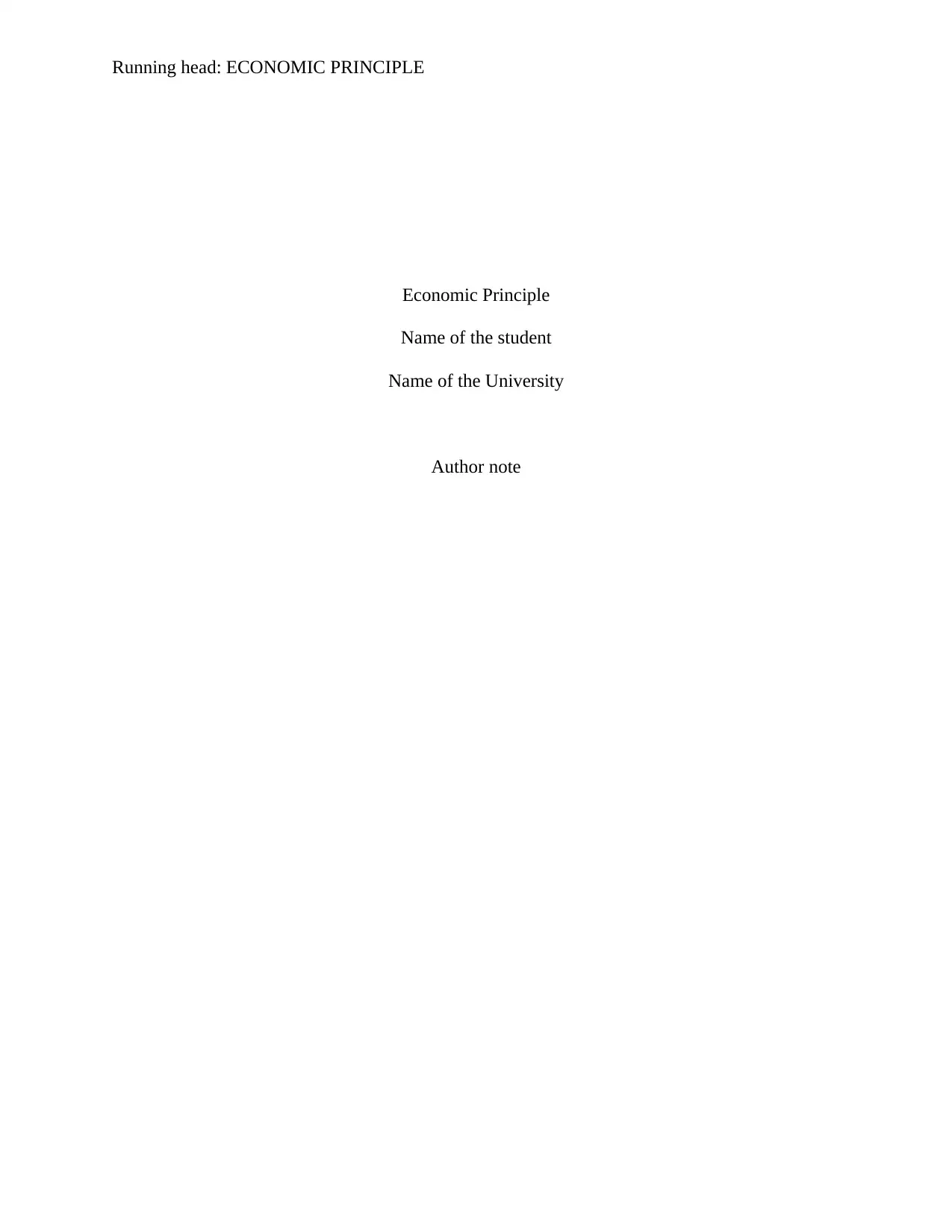
Running head: ECONOMIC PRINCIPLE
Economic Principle
Name of the student
Name of the University
Author note
Economic Principle
Name of the student
Name of the University
Author note
Paraphrase This Document
Need a fresh take? Get an instant paraphrase of this document with our AI Paraphraser
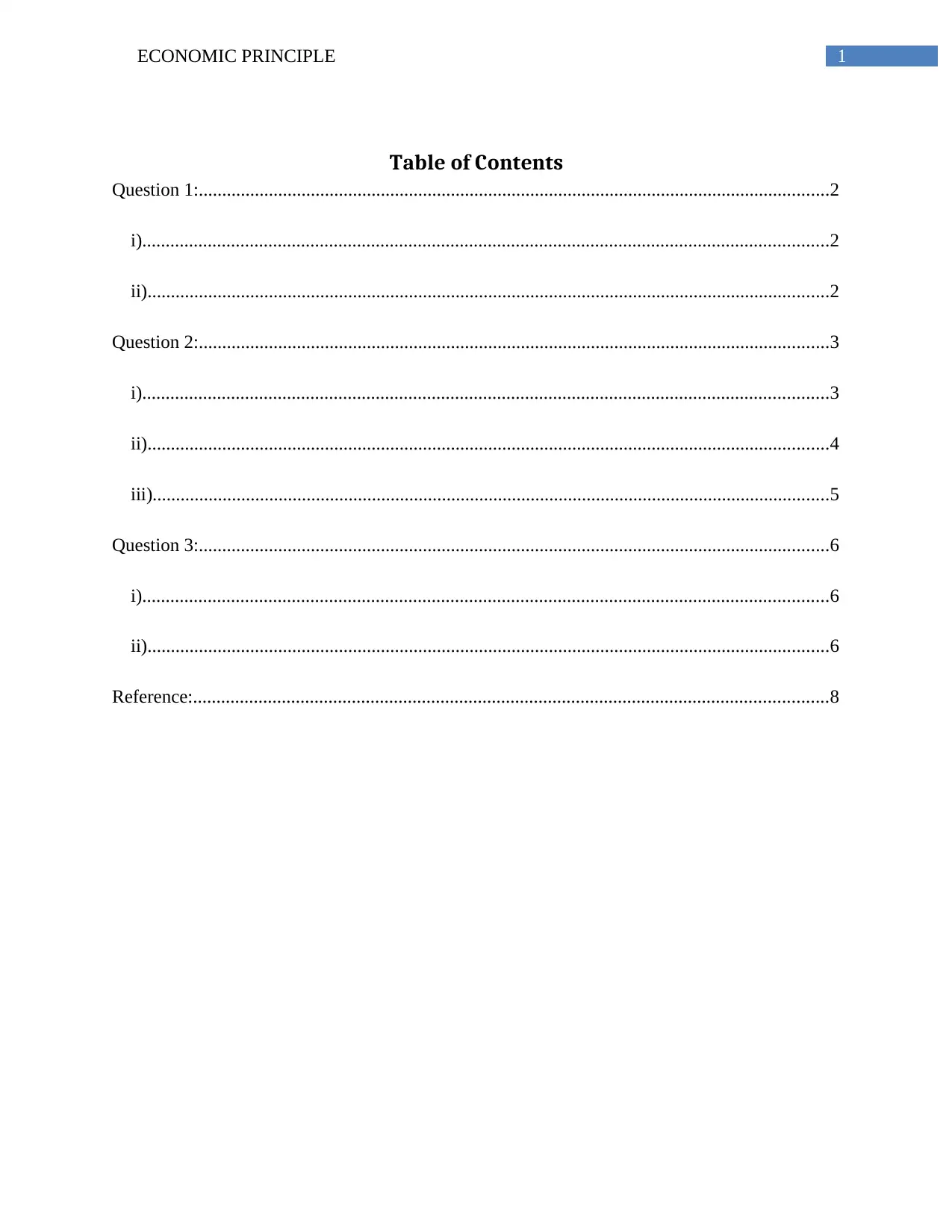
1ECONOMIC PRINCIPLE
Table of Contents
Question 1:.......................................................................................................................................2
i)...................................................................................................................................................2
ii)..................................................................................................................................................2
Question 2:.......................................................................................................................................3
i)...................................................................................................................................................3
ii)..................................................................................................................................................4
iii).................................................................................................................................................5
Question 3:.......................................................................................................................................6
i)...................................................................................................................................................6
ii)..................................................................................................................................................6
Reference:........................................................................................................................................8
Table of Contents
Question 1:.......................................................................................................................................2
i)...................................................................................................................................................2
ii)..................................................................................................................................................2
Question 2:.......................................................................................................................................3
i)...................................................................................................................................................3
ii)..................................................................................................................................................4
iii).................................................................................................................................................5
Question 3:.......................................................................................................................................6
i)...................................................................................................................................................6
ii)..................................................................................................................................................6
Reference:........................................................................................................................................8
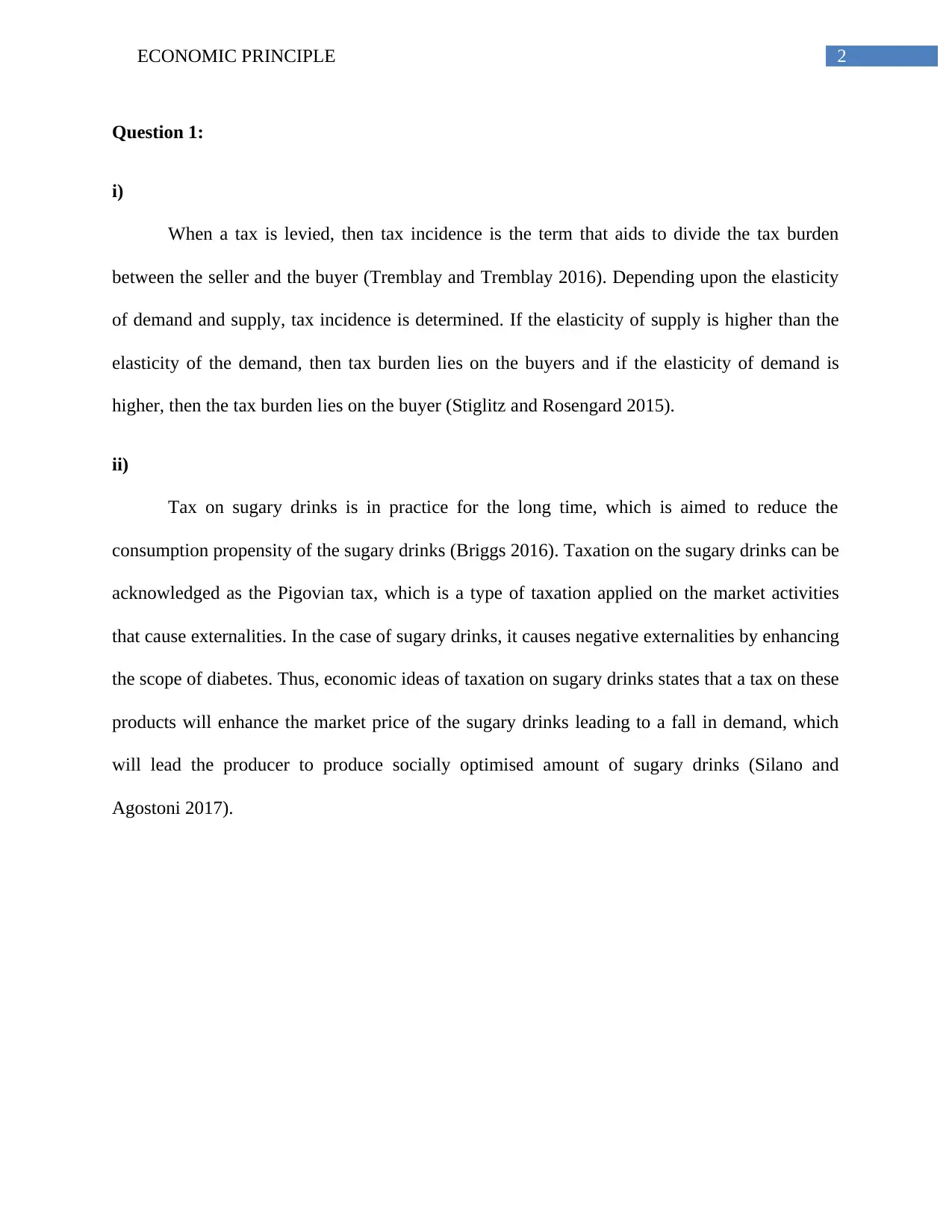
2ECONOMIC PRINCIPLE
Question 1:
i)
When a tax is levied, then tax incidence is the term that aids to divide the tax burden
between the seller and the buyer (Tremblay and Tremblay 2016). Depending upon the elasticity
of demand and supply, tax incidence is determined. If the elasticity of supply is higher than the
elasticity of the demand, then tax burden lies on the buyers and if the elasticity of demand is
higher, then the tax burden lies on the buyer (Stiglitz and Rosengard 2015).
ii)
Tax on sugary drinks is in practice for the long time, which is aimed to reduce the
consumption propensity of the sugary drinks (Briggs 2016). Taxation on the sugary drinks can be
acknowledged as the Pigovian tax, which is a type of taxation applied on the market activities
that cause externalities. In the case of sugary drinks, it causes negative externalities by enhancing
the scope of diabetes. Thus, economic ideas of taxation on sugary drinks states that a tax on these
products will enhance the market price of the sugary drinks leading to a fall in demand, which
will lead the producer to produce socially optimised amount of sugary drinks (Silano and
Agostoni 2017).
Question 1:
i)
When a tax is levied, then tax incidence is the term that aids to divide the tax burden
between the seller and the buyer (Tremblay and Tremblay 2016). Depending upon the elasticity
of demand and supply, tax incidence is determined. If the elasticity of supply is higher than the
elasticity of the demand, then tax burden lies on the buyers and if the elasticity of demand is
higher, then the tax burden lies on the buyer (Stiglitz and Rosengard 2015).
ii)
Tax on sugary drinks is in practice for the long time, which is aimed to reduce the
consumption propensity of the sugary drinks (Briggs 2016). Taxation on the sugary drinks can be
acknowledged as the Pigovian tax, which is a type of taxation applied on the market activities
that cause externalities. In the case of sugary drinks, it causes negative externalities by enhancing
the scope of diabetes. Thus, economic ideas of taxation on sugary drinks states that a tax on these
products will enhance the market price of the sugary drinks leading to a fall in demand, which
will lead the producer to produce socially optimised amount of sugary drinks (Silano and
Agostoni 2017).
⊘ This is a preview!⊘
Do you want full access?
Subscribe today to unlock all pages.

Trusted by 1+ million students worldwide
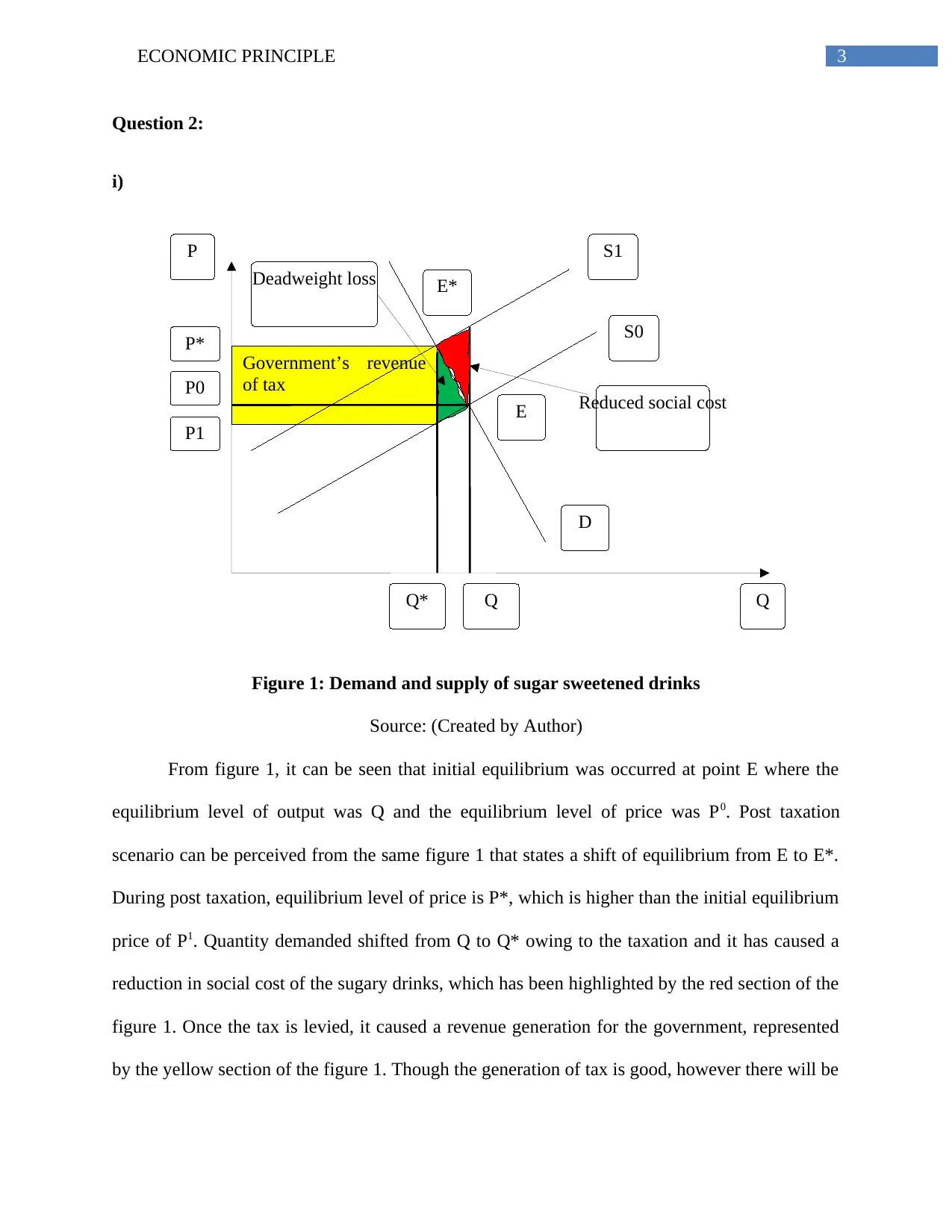
3ECONOMIC PRINCIPLE
Government’s revenue
of tax
S0
D
Q
P
Q
P0
Q*
P1
P*
S1
E*
E
Deadweight loss
Reduced social cost
Question 2:
i)
Figure 1: Demand and supply of sugar sweetened drinks
Source: (Created by Author)
From figure 1, it can be seen that initial equilibrium was occurred at point E where the
equilibrium level of output was Q and the equilibrium level of price was P0. Post taxation
scenario can be perceived from the same figure 1 that states a shift of equilibrium from E to E*.
During post taxation, equilibrium level of price is P*, which is higher than the initial equilibrium
price of P1. Quantity demanded shifted from Q to Q* owing to the taxation and it has caused a
reduction in social cost of the sugary drinks, which has been highlighted by the red section of the
figure 1. Once the tax is levied, it caused a revenue generation for the government, represented
by the yellow section of the figure 1. Though the generation of tax is good, however there will be
Government’s revenue
of tax
S0
D
Q
P
Q
P0
Q*
P1
P*
S1
E*
E
Deadweight loss
Reduced social cost
Question 2:
i)
Figure 1: Demand and supply of sugar sweetened drinks
Source: (Created by Author)
From figure 1, it can be seen that initial equilibrium was occurred at point E where the
equilibrium level of output was Q and the equilibrium level of price was P0. Post taxation
scenario can be perceived from the same figure 1 that states a shift of equilibrium from E to E*.
During post taxation, equilibrium level of price is P*, which is higher than the initial equilibrium
price of P1. Quantity demanded shifted from Q to Q* owing to the taxation and it has caused a
reduction in social cost of the sugary drinks, which has been highlighted by the red section of the
figure 1. Once the tax is levied, it caused a revenue generation for the government, represented
by the yellow section of the figure 1. Though the generation of tax is good, however there will be
Paraphrase This Document
Need a fresh take? Get an instant paraphrase of this document with our AI Paraphraser
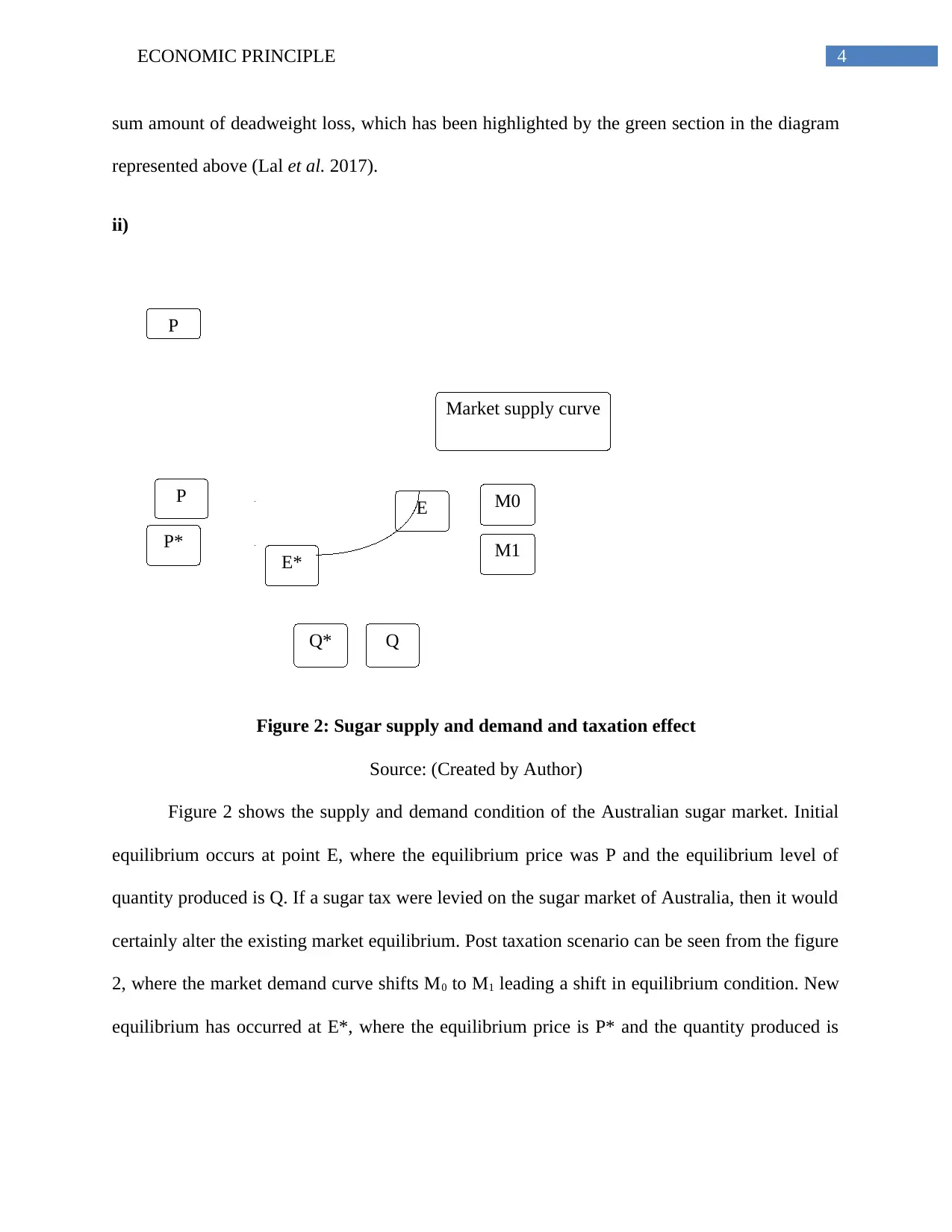
4ECONOMIC PRINCIPLE
E*
E
P
P*
Market supply curve
M1
P
Q* Q
M0
sum amount of deadweight loss, which has been highlighted by the green section in the diagram
represented above (Lal et al. 2017).
ii)
Figure 2: Sugar supply and demand and taxation effect
Source: (Created by Author)
Figure 2 shows the supply and demand condition of the Australian sugar market. Initial
equilibrium occurs at point E, where the equilibrium price was P and the equilibrium level of
quantity produced is Q. If a sugar tax were levied on the sugar market of Australia, then it would
certainly alter the existing market equilibrium. Post taxation scenario can be seen from the figure
2, where the market demand curve shifts M0 to M1 leading a shift in equilibrium condition. New
equilibrium has occurred at E*, where the equilibrium price is P* and the quantity produced is
E*
E
P
P*
Market supply curve
M1
P
Q* Q
M0
sum amount of deadweight loss, which has been highlighted by the green section in the diagram
represented above (Lal et al. 2017).
ii)
Figure 2: Sugar supply and demand and taxation effect
Source: (Created by Author)
Figure 2 shows the supply and demand condition of the Australian sugar market. Initial
equilibrium occurs at point E, where the equilibrium price was P and the equilibrium level of
quantity produced is Q. If a sugar tax were levied on the sugar market of Australia, then it would
certainly alter the existing market equilibrium. Post taxation scenario can be seen from the figure
2, where the market demand curve shifts M0 to M1 leading a shift in equilibrium condition. New
equilibrium has occurred at E*, where the equilibrium price is P* and the quantity produced is
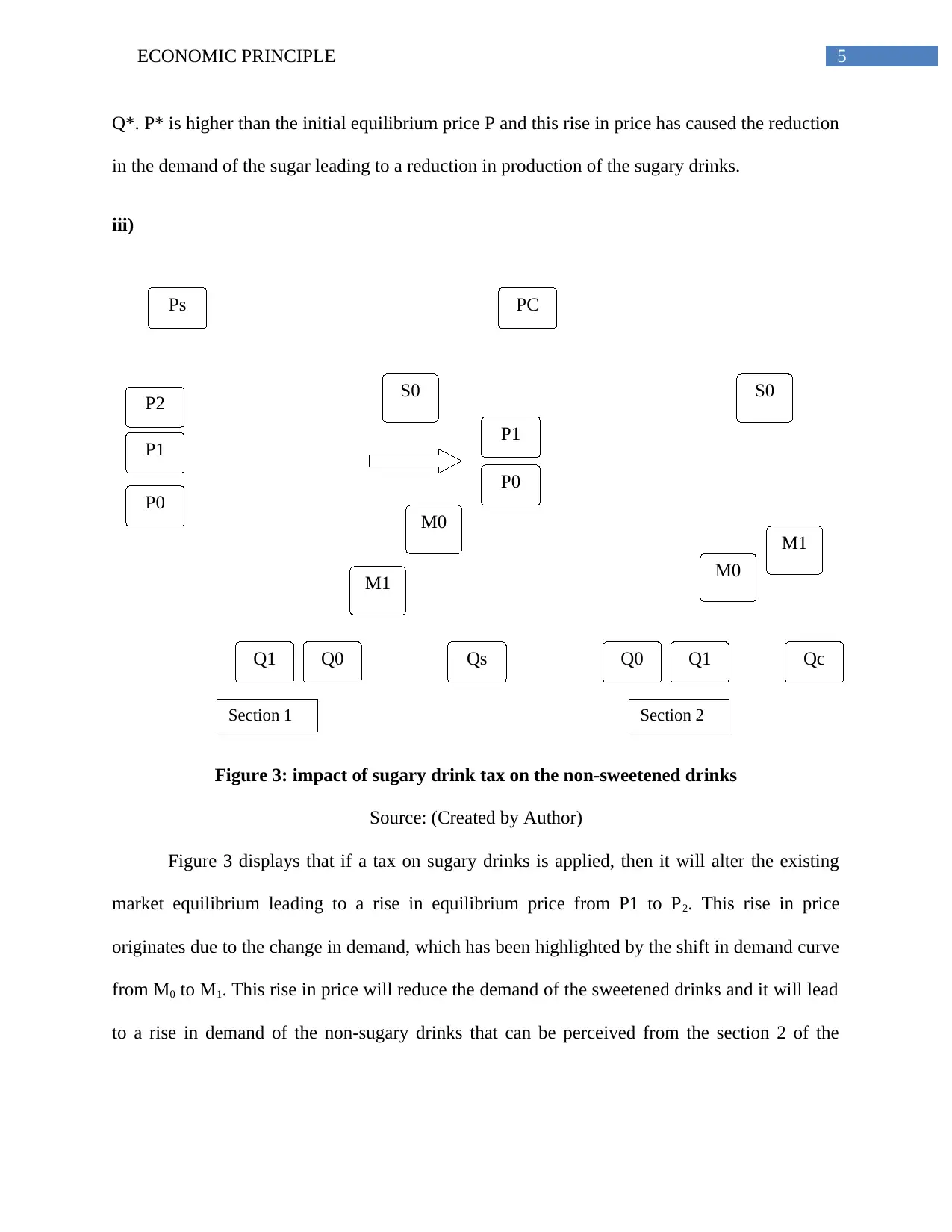
5ECONOMIC PRINCIPLE
P0
P1
P0
P1
Ps
Qs
PC
Qc
M0
M1
S0 S0
Q1 Q0 Q0 Q1
M0
M1
Section 1 Section 2
P2
Q*. P* is higher than the initial equilibrium price P and this rise in price has caused the reduction
in the demand of the sugar leading to a reduction in production of the sugary drinks.
iii)
Figure 3: impact of sugary drink tax on the non-sweetened drinks
Source: (Created by Author)
Figure 3 displays that if a tax on sugary drinks is applied, then it will alter the existing
market equilibrium leading to a rise in equilibrium price from P1 to P2. This rise in price
originates due to the change in demand, which has been highlighted by the shift in demand curve
from M0 to M1. This rise in price will reduce the demand of the sweetened drinks and it will lead
to a rise in demand of the non-sugary drinks that can be perceived from the section 2 of the
P0
P1
P0
P1
Ps
Qs
PC
Qc
M0
M1
S0 S0
Q1 Q0 Q0 Q1
M0
M1
Section 1 Section 2
P2
Q*. P* is higher than the initial equilibrium price P and this rise in price has caused the reduction
in the demand of the sugar leading to a reduction in production of the sugary drinks.
iii)
Figure 3: impact of sugary drink tax on the non-sweetened drinks
Source: (Created by Author)
Figure 3 displays that if a tax on sugary drinks is applied, then it will alter the existing
market equilibrium leading to a rise in equilibrium price from P1 to P2. This rise in price
originates due to the change in demand, which has been highlighted by the shift in demand curve
from M0 to M1. This rise in price will reduce the demand of the sweetened drinks and it will lead
to a rise in demand of the non-sugary drinks that can be perceived from the section 2 of the
⊘ This is a preview!⊘
Do you want full access?
Subscribe today to unlock all pages.

Trusted by 1+ million students worldwide
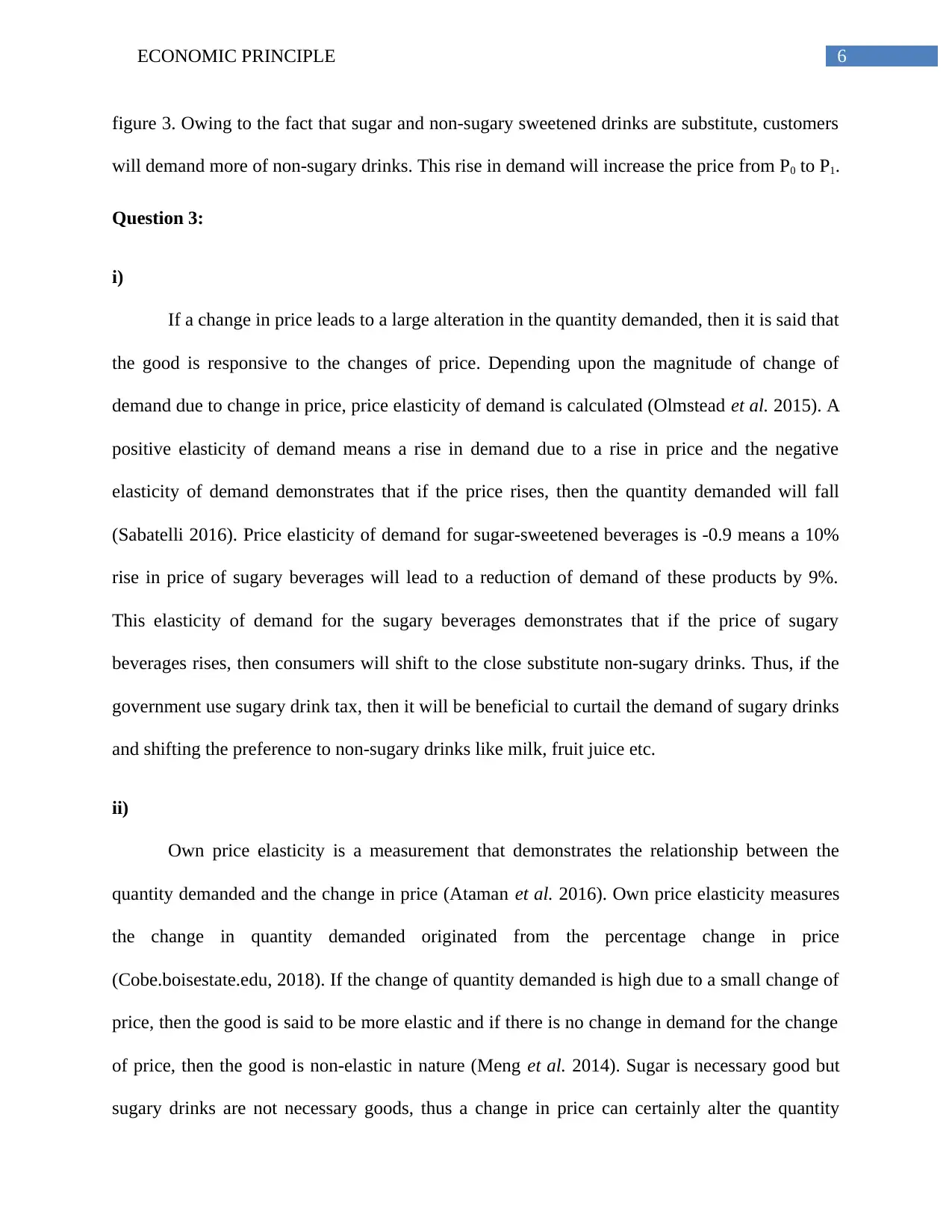
6ECONOMIC PRINCIPLE
figure 3. Owing to the fact that sugar and non-sugary sweetened drinks are substitute, customers
will demand more of non-sugary drinks. This rise in demand will increase the price from P0 to P1.
Question 3:
i)
If a change in price leads to a large alteration in the quantity demanded, then it is said that
the good is responsive to the changes of price. Depending upon the magnitude of change of
demand due to change in price, price elasticity of demand is calculated (Olmstead et al. 2015). A
positive elasticity of demand means a rise in demand due to a rise in price and the negative
elasticity of demand demonstrates that if the price rises, then the quantity demanded will fall
(Sabatelli 2016). Price elasticity of demand for sugar-sweetened beverages is -0.9 means a 10%
rise in price of sugary beverages will lead to a reduction of demand of these products by 9%.
This elasticity of demand for the sugary beverages demonstrates that if the price of sugary
beverages rises, then consumers will shift to the close substitute non-sugary drinks. Thus, if the
government use sugary drink tax, then it will be beneficial to curtail the demand of sugary drinks
and shifting the preference to non-sugary drinks like milk, fruit juice etc.
ii)
Own price elasticity is a measurement that demonstrates the relationship between the
quantity demanded and the change in price (Ataman et al. 2016). Own price elasticity measures
the change in quantity demanded originated from the percentage change in price
(Cobe.boisestate.edu, 2018). If the change of quantity demanded is high due to a small change of
price, then the good is said to be more elastic and if there is no change in demand for the change
of price, then the good is non-elastic in nature (Meng et al. 2014). Sugar is necessary good but
sugary drinks are not necessary goods, thus a change in price can certainly alter the quantity
figure 3. Owing to the fact that sugar and non-sugary sweetened drinks are substitute, customers
will demand more of non-sugary drinks. This rise in demand will increase the price from P0 to P1.
Question 3:
i)
If a change in price leads to a large alteration in the quantity demanded, then it is said that
the good is responsive to the changes of price. Depending upon the magnitude of change of
demand due to change in price, price elasticity of demand is calculated (Olmstead et al. 2015). A
positive elasticity of demand means a rise in demand due to a rise in price and the negative
elasticity of demand demonstrates that if the price rises, then the quantity demanded will fall
(Sabatelli 2016). Price elasticity of demand for sugar-sweetened beverages is -0.9 means a 10%
rise in price of sugary beverages will lead to a reduction of demand of these products by 9%.
This elasticity of demand for the sugary beverages demonstrates that if the price of sugary
beverages rises, then consumers will shift to the close substitute non-sugary drinks. Thus, if the
government use sugary drink tax, then it will be beneficial to curtail the demand of sugary drinks
and shifting the preference to non-sugary drinks like milk, fruit juice etc.
ii)
Own price elasticity is a measurement that demonstrates the relationship between the
quantity demanded and the change in price (Ataman et al. 2016). Own price elasticity measures
the change in quantity demanded originated from the percentage change in price
(Cobe.boisestate.edu, 2018). If the change of quantity demanded is high due to a small change of
price, then the good is said to be more elastic and if there is no change in demand for the change
of price, then the good is non-elastic in nature (Meng et al. 2014). Sugar is necessary good but
sugary drinks are not necessary goods, thus a change in price can certainly alter the quantity
Paraphrase This Document
Need a fresh take? Get an instant paraphrase of this document with our AI Paraphraser
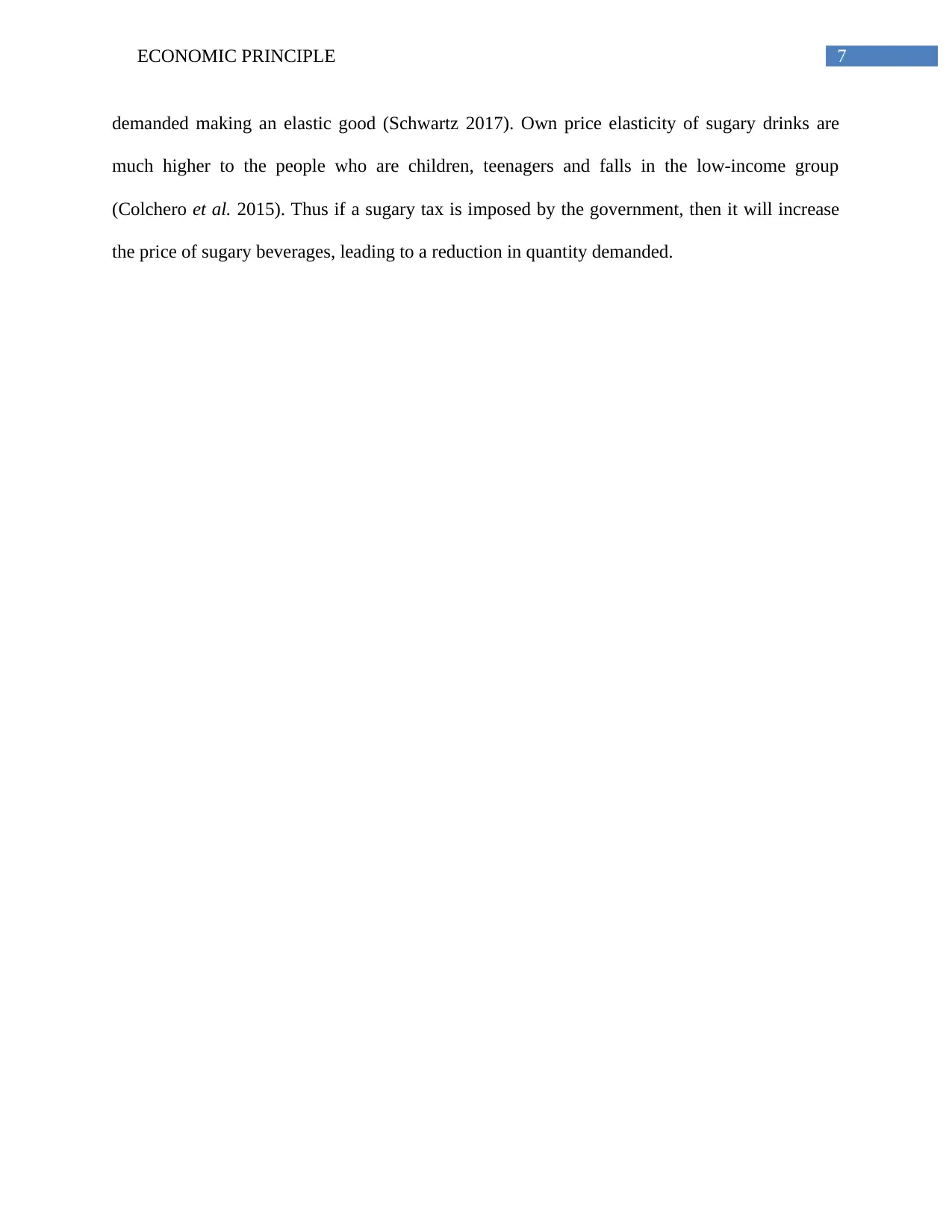
7ECONOMIC PRINCIPLE
demanded making an elastic good (Schwartz 2017). Own price elasticity of sugary drinks are
much higher to the people who are children, teenagers and falls in the low-income group
(Colchero et al. 2015). Thus if a sugary tax is imposed by the government, then it will increase
the price of sugary beverages, leading to a reduction in quantity demanded.
demanded making an elastic good (Schwartz 2017). Own price elasticity of sugary drinks are
much higher to the people who are children, teenagers and falls in the low-income group
(Colchero et al. 2015). Thus if a sugary tax is imposed by the government, then it will increase
the price of sugary beverages, leading to a reduction in quantity demanded.
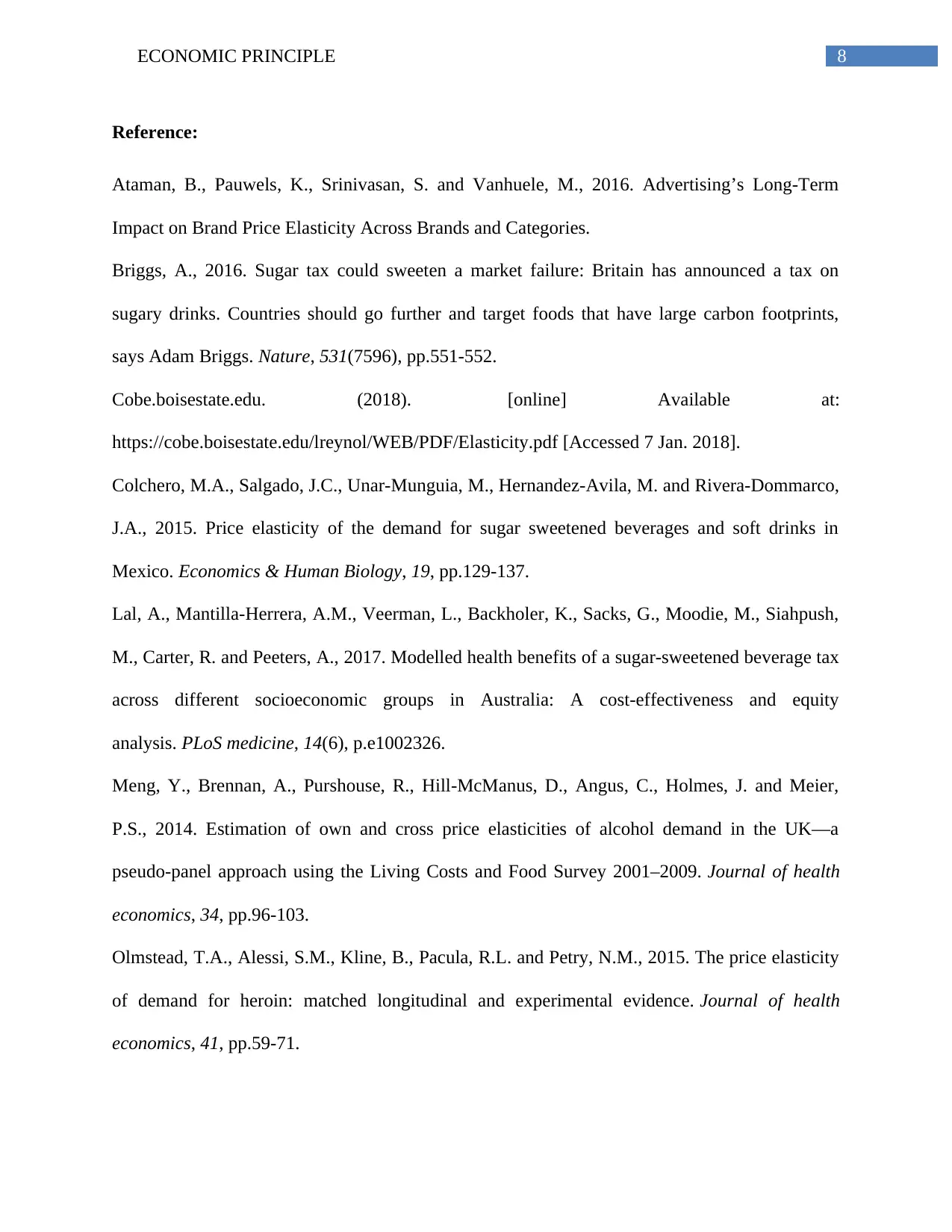
8ECONOMIC PRINCIPLE
Reference:
Ataman, B., Pauwels, K., Srinivasan, S. and Vanhuele, M., 2016. Advertising’s Long-Term
Impact on Brand Price Elasticity Across Brands and Categories.
Briggs, A., 2016. Sugar tax could sweeten a market failure: Britain has announced a tax on
sugary drinks. Countries should go further and target foods that have large carbon footprints,
says Adam Briggs. Nature, 531(7596), pp.551-552.
Cobe.boisestate.edu. (2018). [online] Available at:
https://cobe.boisestate.edu/lreynol/WEB/PDF/Elasticity.pdf [Accessed 7 Jan. 2018].
Colchero, M.A., Salgado, J.C., Unar-Munguia, M., Hernandez-Avila, M. and Rivera-Dommarco,
J.A., 2015. Price elasticity of the demand for sugar sweetened beverages and soft drinks in
Mexico. Economics & Human Biology, 19, pp.129-137.
Lal, A., Mantilla-Herrera, A.M., Veerman, L., Backholer, K., Sacks, G., Moodie, M., Siahpush,
M., Carter, R. and Peeters, A., 2017. Modelled health benefits of a sugar-sweetened beverage tax
across different socioeconomic groups in Australia: A cost-effectiveness and equity
analysis. PLoS medicine, 14(6), p.e1002326.
Meng, Y., Brennan, A., Purshouse, R., Hill-McManus, D., Angus, C., Holmes, J. and Meier,
P.S., 2014. Estimation of own and cross price elasticities of alcohol demand in the UK—a
pseudo-panel approach using the Living Costs and Food Survey 2001–2009. Journal of health
economics, 34, pp.96-103.
Olmstead, T.A., Alessi, S.M., Kline, B., Pacula, R.L. and Petry, N.M., 2015. The price elasticity
of demand for heroin: matched longitudinal and experimental evidence. Journal of health
economics, 41, pp.59-71.
Reference:
Ataman, B., Pauwels, K., Srinivasan, S. and Vanhuele, M., 2016. Advertising’s Long-Term
Impact on Brand Price Elasticity Across Brands and Categories.
Briggs, A., 2016. Sugar tax could sweeten a market failure: Britain has announced a tax on
sugary drinks. Countries should go further and target foods that have large carbon footprints,
says Adam Briggs. Nature, 531(7596), pp.551-552.
Cobe.boisestate.edu. (2018). [online] Available at:
https://cobe.boisestate.edu/lreynol/WEB/PDF/Elasticity.pdf [Accessed 7 Jan. 2018].
Colchero, M.A., Salgado, J.C., Unar-Munguia, M., Hernandez-Avila, M. and Rivera-Dommarco,
J.A., 2015. Price elasticity of the demand for sugar sweetened beverages and soft drinks in
Mexico. Economics & Human Biology, 19, pp.129-137.
Lal, A., Mantilla-Herrera, A.M., Veerman, L., Backholer, K., Sacks, G., Moodie, M., Siahpush,
M., Carter, R. and Peeters, A., 2017. Modelled health benefits of a sugar-sweetened beverage tax
across different socioeconomic groups in Australia: A cost-effectiveness and equity
analysis. PLoS medicine, 14(6), p.e1002326.
Meng, Y., Brennan, A., Purshouse, R., Hill-McManus, D., Angus, C., Holmes, J. and Meier,
P.S., 2014. Estimation of own and cross price elasticities of alcohol demand in the UK—a
pseudo-panel approach using the Living Costs and Food Survey 2001–2009. Journal of health
economics, 34, pp.96-103.
Olmstead, T.A., Alessi, S.M., Kline, B., Pacula, R.L. and Petry, N.M., 2015. The price elasticity
of demand for heroin: matched longitudinal and experimental evidence. Journal of health
economics, 41, pp.59-71.
⊘ This is a preview!⊘
Do you want full access?
Subscribe today to unlock all pages.

Trusted by 1+ million students worldwide
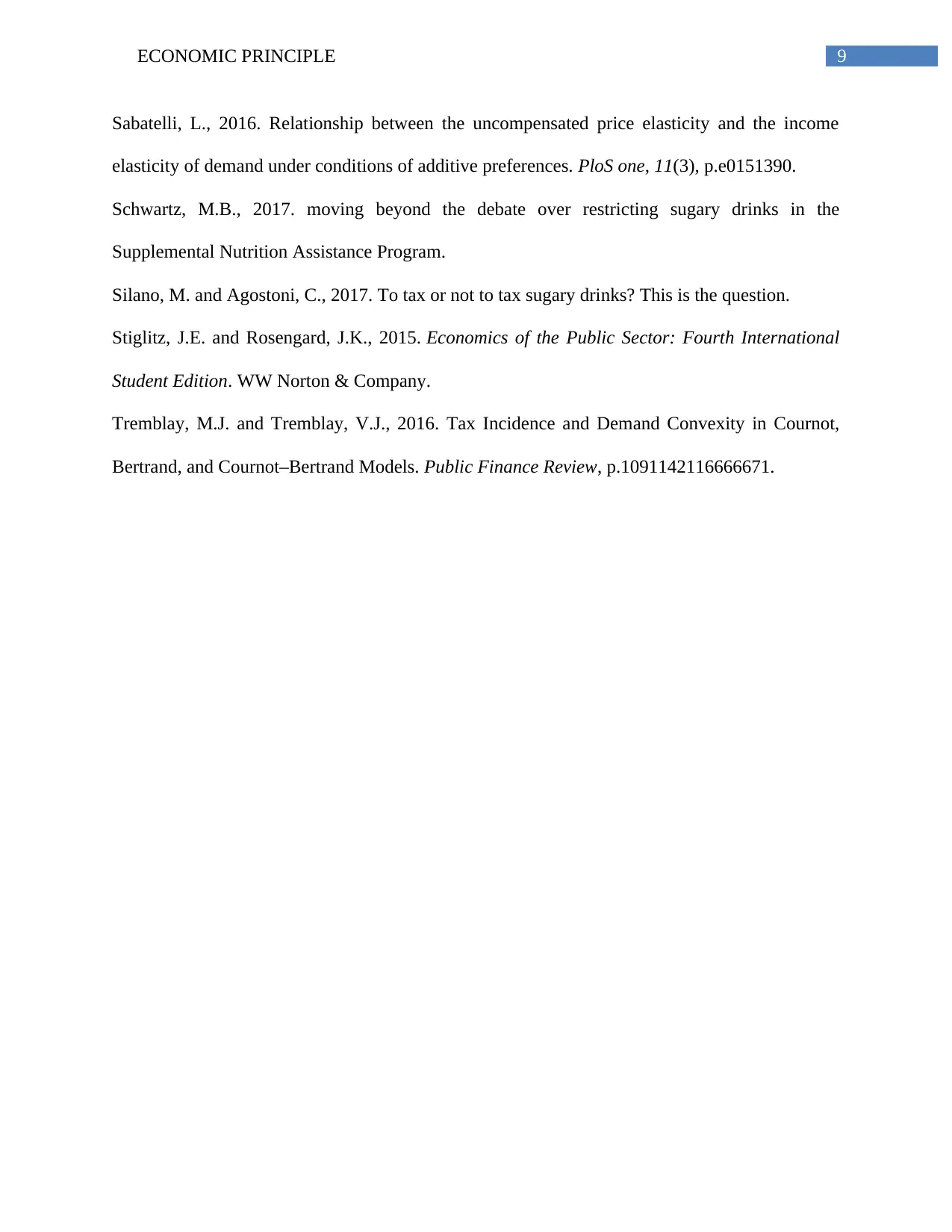
9ECONOMIC PRINCIPLE
Sabatelli, L., 2016. Relationship between the uncompensated price elasticity and the income
elasticity of demand under conditions of additive preferences. PloS one, 11(3), p.e0151390.
Schwartz, M.B., 2017. moving beyond the debate over restricting sugary drinks in the
Supplemental Nutrition Assistance Program.
Silano, M. and Agostoni, C., 2017. To tax or not to tax sugary drinks? This is the question.
Stiglitz, J.E. and Rosengard, J.K., 2015. Economics of the Public Sector: Fourth International
Student Edition. WW Norton & Company.
Tremblay, M.J. and Tremblay, V.J., 2016. Tax Incidence and Demand Convexity in Cournot,
Bertrand, and Cournot–Bertrand Models. Public Finance Review, p.1091142116666671.
Sabatelli, L., 2016. Relationship between the uncompensated price elasticity and the income
elasticity of demand under conditions of additive preferences. PloS one, 11(3), p.e0151390.
Schwartz, M.B., 2017. moving beyond the debate over restricting sugary drinks in the
Supplemental Nutrition Assistance Program.
Silano, M. and Agostoni, C., 2017. To tax or not to tax sugary drinks? This is the question.
Stiglitz, J.E. and Rosengard, J.K., 2015. Economics of the Public Sector: Fourth International
Student Edition. WW Norton & Company.
Tremblay, M.J. and Tremblay, V.J., 2016. Tax Incidence and Demand Convexity in Cournot,
Bertrand, and Cournot–Bertrand Models. Public Finance Review, p.1091142116666671.
1 out of 10
Related Documents
Your All-in-One AI-Powered Toolkit for Academic Success.
+13062052269
info@desklib.com
Available 24*7 on WhatsApp / Email
![[object Object]](/_next/static/media/star-bottom.7253800d.svg)
Unlock your academic potential
Copyright © 2020–2025 A2Z Services. All Rights Reserved. Developed and managed by ZUCOL.





